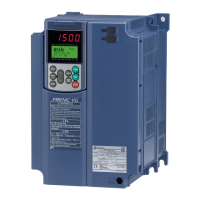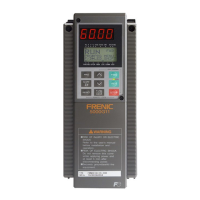deceleration by soft-start and stop (acceleration/deceleration time) at the time of startup and stop.
Turning ON a run command starts the inverter to run and outputs the commanded torque. Turning it OFF
stops the inverter so that the motor coasts to a stop.
At the startup in torque control under the "Vector control without speed sensor," the starting operation differs
depending upon whether auto-search is enabled or disabled by d67 as shown below.
Data for d67 Operation
0: Disable
1: Enable (At restart after
momentary power failure)
At startup, the inverter first starts at zero frequency. Then it accelerates
according to a torque command.
Select this operation for use in which the motor is surely stopped before
startup.
2: Enable (At normal start and
at restart after momentary
power failure)
At startup, the inverter searches for idling motor speed and starts
running the motor at the frequency base on the searched speed. Then it
starts torque control.
H26, H27 Thermistor (for motor) (Mode selection and Level)
These function codes specify the PTC (Positive Temperature Coefficient)/NTC (Negative Temperature Coefficient)
thermistor embedded in the motor. The thermistor is used to protect the motor from overheating or output an alarm
signal.
Thermistor (for motor) (Mode selection) (H26)
H26 selects the function operation mode (protection or alarm) for the PTC/NTC thermistor as shown below.
Data for H26 Action
0 Disable
1
Enable
When the voltage sensed by PTC thermistor exceeds the detection level, motor protective function
(alarm 0h4 ) is triggered, causing the inverter to enter an alarm stop state.
2
Enable
When the voltage sensed by the PTC thermistor exceeds the detection level, a motor alarm signal is
output but the inverter continues running. You need to assign the "Motor overheat detected by
thermistor" signal (THM) to one of the digital output terminals beforehand, by which a temperature
alarm condition can be detected by the thermistor (PTC) (E20 to E24 and E27, data = 56).
3
Enable
When the inverter is connected with the NTC thermistor built into the Fuji VG motor exclusively
designed for vector control, the inverter senses the motor temperature and uses the information for
control.
If the motor overheats and the temperature exceeds the protection level, the inverter issues the
Motor protection alarm 0h4 and stops the motor.
If H26 data is set to "1" or "2" (PTC thermistor), the inverter monitors the voltage sensed by PTC thermistor and protect
the motor even when any of the 2nd to 4th motors is selected. If H26 data is set to "3" (NTC thermistor) and any of the
2nd to 4th motors is selected, the inverter does not perform these functions.
Thermistor (for motor) (Level) (H27) Data setting range: 0.00 to 5.00 (V)
H27 specifies the detection level (expressed in voltage) for the temperature sensed by the PTC thermistor.
The alarm temperature at which the overheat protection becomes activated depends on the characteristics of the PTC
thermistor. The internal resistance of the thermistor will significantly change at the alarm temperature. The detection
level (voltage) is specified based on the change of the internal resistance.
Suppose that the internal resistance of the PTC thermistor at the alarm temperature is Rp, the detection level (voltage)
V
v2
is calculated by the expression below. Set the result V
v2
to function code H27.
(V)10.5
Rp27000
R
×
p
V2
V
+
=

